Abstract
There is a lack of awareness and understanding of how to manage waste effectively in Indonesia, especially in coastal rural areas. This paper discusses the important issues in waste management and proposes effective waste management practices in Indonesia. This paper also provides a case study involving the qualitative and quantitative analysis of the waste bank project in Pangandaran, Indonesia, and its impact on the community, reflected by the perceptions of its operators and customers, which was achieved through several questionnaires. The results showed that waste banks are a viable option to manage waste in Pangandaran. This is based on the finding that waste banks have created employment opportunities and raised awareness among the community about how to manage waste effectively. The waste bank also enables its members to earn income from recycling, which provides benefits to the community and encourages further participation in the waste bank program. The most important finding is that community-based projects can provide engagement-generating value to communities and can be sustainably run by the community independently and in the long term. Nevertheless, the success and operational sustainability of waste banks are affected by many factors, hence endorsement from municipal authorities, non-profit entities, corporations, and additional interested parties is needed.
1. Introduction
Indonesia is currently facing a waste management crisis because waste is being poorly disposed via illegal dumping in ecologically sensitive habitats and by burning and burying it inappropriately [1]. The accumulation of waste can result in the breeding of insects and parasites, discharge of unpleasant odors, unsightliness, and contribution to global warming (environmental concerns) [2]. The mixing of organic and inorganic waste is the main cause of these problems. Effective waste management is hindered by numerous factors, including limited education and economic constraints. Enhancing public education on proper waste disposal practices, such as through the implementation of a waste management program for village residents, is essential. It is reported that this program resulted in better waste management practices and, consequently, reduced pollution [3,4,5,6]. It has been ascertained that within the Pangandaran Regency of the West Java Province, which is a prominent tourist destination, particularly in the province itself, these concerns have the potential to manifest with considerable severity. The increase in the number of tourists attracted to the region has led to increased waste production, posing significant environmental threats to residents.
One of the popular destinations in West Java, Indonesia, is the Pangandaran regency, which has popular beach regions located at the southern counterpart of West Java. Pangandaran is a coastal city in West Java with a population of approximately 190,000 people. The city has more than 1000 private hotels and nearly 1000 residential areas. Poor waste management is prevalent, particularly in tourist destinations, such as Pangandaran. Because the ocean makes up the majority of Pangandaran, most human operations involving water, soil, and waste will ultimately affect the ocean. Our survey indicates that rather than giving municipal waste to waste disposal personnel, Pangandaran inhabitants would burn and bury it in the backyard, or throw it into a river. In particular, the latter practice leads to the ingestion of microplastics by marine organisms [7]. However, decreased waste collection by waste disposal personnel can contribute to a decrease in landfill waste. However, ineffective waste management may jeopardize the environment and degrade soil quality. This scenario becomes most severe when the population cannot afford to buy or pay for better waste management services. This situation will cause it to be even costlier for environmental resources. Overall, microplastic contamination in groundwater and municipal waste seems to have increased over time. This suggests that there is still room for improvement in waste management, especially in tourist destinations such as Pangandaran. A good solution to this problem would be to implement environmentally friendly and economically viable waste management practices. It only needs the local population’s awareness and their willingness to cooperate.
To manage waste at the sub-village level, local populations can establish and operate a waste bank. Waste banks implement the 3Rs (reuse, reduce, and recycle) technique for waste management [8]. In a waste bank, inorganic waste can vary by more than 16 variants, including paper, glass, metal, and textiles [9]. Residents in the neighborhood can sign up as customers at the waste bank and deposit their inorganic waste. By implementing waste banks, individuals may inadvertently become more knowledgeable about organic and inorganic wastes. Moreover, by cooperating with waste banks, individuals may be able to improve their standards of living [8,10,11]. Additionally, the establishment of waste banks may contribute to greater public awareness of the importance of environmental protection [12]. The use of waste management, such as waste banks, can therefore promote an ecofriendly lifestyle for both consumers and society.
This study aimed to evaluate the implementation of waste management systems, specifically waste banks, in Pangandaran sub-villages, reflected by the perception of its committees (operators) and customers on its operation. The findings of this study can provide further insight into the development and promotion of waste management systems, along with directions for future improvements and enhancement of the management of environmental resources in Pangandaran sub-villages and other similar areas.
2. Materials and Methods
2.1. General Information of Study Area
This study was conducted in Pangandaran Regency, West Java, Indonesia (coordinate: 7°42′09.6″ S 108°39′22.1″ E) in 2020. Pangandaran is a major tourist destination in Indonesia and is popular for its beaches. The climate of Pangandaran is tropical, with a temperate dry season and a hot, humid rainy season, which is due to its proximity to the Indian Ocean. As a major tourist destination, the number of hotels and restaurants is on the rise, leading to an increase in waste. Waste management at the sub-village level is important as it is a vital part of daily life. Moreover, the rivers and beaches in Pangandaran are highly polluted due to waste management practices at the sub-village level. Most residents dispose of their waste in rivers and on beaches, which leads to health threats and environmental pollution. Therefore, the sub-villages in Pangandaran established waste banks and educated the community about the importance of waste management.
Moreover, in the socio-demographic scene, local inhabitants of Pangandaran can be categorized into Sundanese (70%) and Javanese (30%) ethnic groups. This cultural scene is important to the way communities behave, socialize with each other, and act on a certain level of work ethics. The Sundanese and Javanese culture taught that engagement and individual contributions within the community are important; therefore, they must work together to achieve the same target. This culture became the background and social capital of the general Pangandaran inhabitants.
In addition to the aforementioned points, the customers and committee members of waste banks in this study are all females and had low income and education levels, with their primary occupation being either animal or rice and horticulture farm worker. Furthermore, it was observed that all female customers and committee members of waste banks in this study were financially dependent on their husbands’ also low incomes.
2.2. Waste Bank Establishments
The establishment of the waste bank began by contacting the village head (Kepala Desa) at their government office in the village (Kantor Desa or Balai Desa). The village head recommended several active women society groups in the village. First, women’s society group activities are mainly focused on health services (Posyandu). Through this institution, we offered the idea of the establishment of a waste bank, including its benefits, and main activities, and finally provided technical support. Each women’s society group was exposed to the waste bank workflow, its benefits, and activities. In total, we were able to establish waste banks in six women’s society groups in the district of Cijulang in Pangandaran Regency, West Java Province. We also contacted the plastic waste aggregator (pengepul) to ensure that the collected plastic waste will be available to be converted into cash.
The plan to approach these women’s society groups to establish a waste bank is the procedure that is regularly employed in Indonesia. To make this societal approach smooth, we also worked together with an international nongovernment organization (NGO) in Pangandaran, which has extensive experience in waste bank establishment, namely CLEAR Community.
2.3. Waste Bank Data Collections and Analysis
Data were collected from six different waste banks throughout Pangandaran Regency with help from the authors. The data were collected between January and June 2022. Questionnaires were distributed to and filled by all customers and committees of the waste bank (Table 1). The questionnaire consisted of three parts: the introduction letter; the questions related to waste bank operationalization; and a section that measured perception variables, such as willingness, benefits, obstacles, and waste sorting behavior in relation to the waste bank operationalization. A five-point Likert scale was applied for the variables with the following responses: strongly agree = 5, agree = 4, neutral = 3, disagree = 2, and strongly disagree = 1. The data and results of the questionnaire were analyzed using descriptive statistics. This investigation employed a mixed-methods approach to examine the perceptions of committees and customers towards waste banks operationalization, as delineated by Miftahorrozi et al. (2022) [13]. The qualitative aspect comprised surveys and observations, including the administration of interviews and questionnaires to stakeholders and close observation of the research subject. The study was conducted in several phases, encompassing literature reviews, waste bank establishments, data acquisition, and analysis of both primary and secondary data. Secondary data encompassed waste generation, composition, and recycling potential, while primary data pertained to the perceptions of waste banks committees and customers on activities of waste bank operations. The quantitative method entailed calculating the volume of waste generated by waste banks in Pangandaran and analyzing questionnaire responses.

Table 1.
Detailed information of waste banks established with assistance from the authors.
The evaluation of the effectiveness of waste management awareness initiatives was carried out through a survey conducted six months to a year after the establishment and stable operation of a waste bank, hence there will a lot of difference in the time of the survey from the waste bank’s committee and customers point of view. For some of the waste banks established in 2020, stable operations were achieved during 2021 despite the COVID-19 pandemic that hindered direct gathering among committees and customers. Due to the absence of a prospective waste bank committee and the inability of potential customers to envision the functioning of a waste bank, it was not feasible to conduct a survey prior to the establishment of the waste banks. Consequently, it is presumed that before the waste bank became operational, sub-village communities had no awareness or ability to plan for waste management.
3. Results and Discussion
3.1. Establishing Waste Bank in Pangandaran
The implementation of waste banks is an effective grassroots approach to enhancing community awareness of local and voluntary waste management. This method aligns with the findings of [14], which suggest that waste bank innovation at the grassroots level can promote proper waste management practices and improve the economic conditions of impoverished individuals. Six waste banks were set up in Pangandaran Regency from May 2020 to July 2022. Most were in the Cijulang subdistrict (Figure 1). The names of the waste banks are Lebah, Hikmah, Caykung, Sehat, Geulis, and Sabuga (Table 1). As a result of the establishment of the waste banks, customers were defined as those who store their waste and will benefit from its disposal at the end of the cycle.
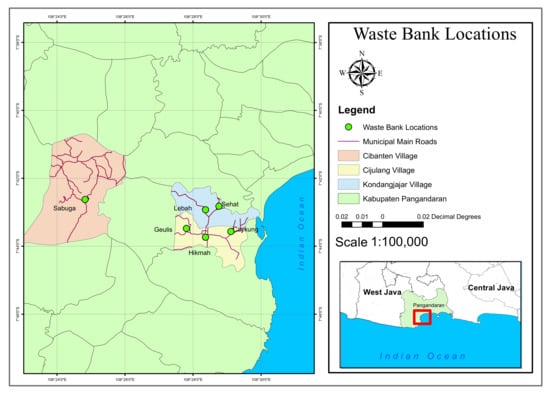
Figure 1.
The location of established waste banks in Cijulang District, Pangandaran Regency in this study.
The socio-demographic characteristics of the families participating in established waste banks are presented in Table 2. It should be noted that only mothers of the family were directly involved in waste banks as either committee members or customers. A total of 183 households, comprising 805 individuals (378 males and 427 females), participated in the study. Of these households, 80% had more than four family members. The majority of women (72.5%) and men (63.3%) had low levels of education. The predominant occupation among women (51.5%) in these households was farming and agricultural labor. However, the data also indicate that the surveyed women were engaged in a variety of low-income occupations, with 16% as small-scale merchants, 5% as fishermen, 12% as part-time (nonformal) government employees, and 14% as housewives.

Table 2.
Socio-demographic characteristics of households (n = 183) involved in waste banks in this study.
Each waste bank performs weekly routines, including depositing, weighing, and sorting waste according to its categories. However, according to a previous study, waste bank committee and customers were encouraged to conduct secondary activities to increase engagement and enthusiasm among them [15]. Hence, they engaged in other secondary activities in between, such as composting, generating eco-enzymes, and creating useful crafts from plastic waste. These secondary activities aimed to increase engagement and collaboration among community members as well as improve the quality of waste management practices.
The production of eco-enzymes represents a strategy for managing organic waste while increasing the engagement among waste bank committee and customers. Our most recent eco-enzyme project, conducted in collaboration with the Geulis waste bank, yielded a high-quality fermented eco-enzyme that exhibited bactericidal activity while retaining its fresh fruity aroma. According to the findings, women from the Geulis waste bank responded well to making eco-enzyme and utilized it as a cleaning solution for their homes.
Other type of activities include handcrafting projects at the Lebah waste bank. At first, every single waste bank customer was excited about the prospect of making a product from plastic waste. However, customers struggled to craft a product during the handcrafting sessions. They were unable to complete this exercise in time because handcrafting required a high level of attention. Moreover, this activity is time- and labor-intensive. Ultimately, they opted to abandon this activity in search of an alternative that is more simplistic and productive.
The community-based waste management approach is based on the cooperative concept with the common goal of making changes in communal solid waste management in terms of source segregation, recovery of recyclable materials, and storage before collection [16]. Briefly, the primary function of a waste bank is to serve as a repository for the collection and management of solid waste brought by customers, which is then sold to a recycler once an agreed-upon volume has been reached between the waste bank and the recycler [3,17]. Subsequently, the revenue generated from the sale to the recycler becomes an income source for the waste bank, which can then be distributed to customers at an agreed-upon time. The waste bank concept was first introduced in Thailand in 2006 [4]. Based on this approach, a community project can create a sense of belonging, together with the citizen roles of members, to solve common environmental problems in a community. Successful projects were reported, such as the community-based composting projects from slums in Bangladesh; the established waste bank in Malang (WBM), as reported by [13]; the community composting and recycling schemes in Borommatrilokanat 21 community in Phisanulok province Thailand; and the “garbage for eggs” project in the Klong Toey slum in Bangkok [16].
In many community projects, community organization is established in the form of a cooperative (co-op). A small group of customers was selected to perform the management and administration tasks; therefore, they had the role of committee members. Locally initiated projects can create a sense of ownership and encourage all community members to participate.
These projects reduced the significant littering of waste and improve community solid waste management, health problems of the slums, and a cleaner living environment. In terms of economic benefits, the project could create jobs and supplementary income within the community, while the municipality could reduce the costs of solid waste handling and disposal [18,19].
3.2. Waste Collection
The Lebah waste bank had the highest total waste compared to the other waste banks (Figure 2). The total waste collected is related to the number of customers. The total number of members of the Lebah Waste Bank was quite high at 43 people (Table 1). This was followed by the Hikmah waste bank, which had the highest number of customers and 50 people, with the second highest total waste collected. The Caykung Waste Bank had the lowest total amount of waste.
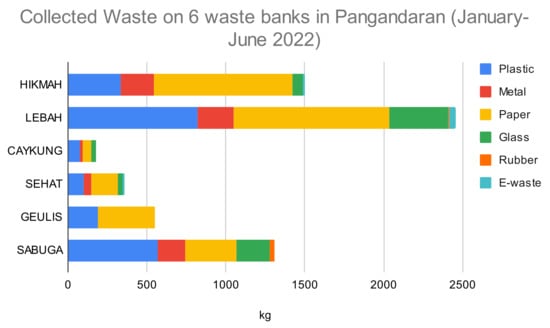
Figure 2.
Different waste categories collected (in kg) on different six waste banks in Pangandaran from January to June 2022.
The amount of collected waste does not define whether the waste bank is good or bad. The Caykung waste bank had few customers, and its operations were not as active as those of the other waste banks. This indicates that the Caykung Waste Bank’s overall waste collection is less than that of the other waste banks and that the total amount of collected waste is not suitable as an index for measuring the performance of a waste bank.
Additionally, the placement of the waste bank and residents’ behavior had an impact on the overall volume of waste collected, which is in agreement with the study by [20] that claimed that reducing the distance between a waste bank location and its customers increases the amount of material collected. As a result, the waste bank’s success cannot be determined solely by the volume of waste that is collected but also by the waste bank location and the total number of customers who are dedicated and consistent enough to keep the waste bank in operation.
In Pangandaran, accumulatively throughout all waste banks, the highest type of waste collected is paper, accounting for approximately half of the waste collected (Figure 3). Paper waste includes cardboard, duplexes, and copy paper. The second-largest category of waste is plastic, with 30.2% of the waste being bottles, lids, glass plastic, and bags/sachets. Rubber makes up the smallest category of waste, with 0.7% of the waste being collected from waste banks (Figure 3; orange color). Rubber and e-waste are rare items in waste banks. Hence, their percentages are quite small compared to those of other waste types.
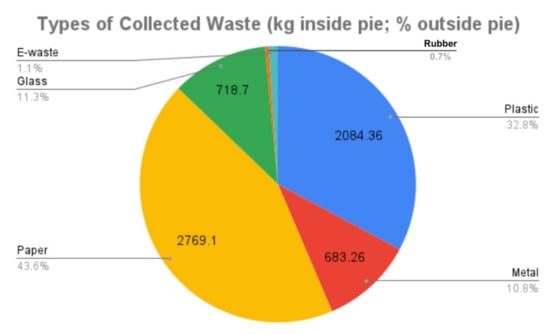
Figure 3.
Percentage of six different waste categories collected from six waste banks in Pangandaran from January to June 2022.
Interestingly, all waste variants decreased in May and drastically increased in June (Figure 4). This phenomenon occurs because the activities of all waste banks are stopped during Ramadan in May. Therefore, all the waste collected in May was deposited in the waste bank in June. Therefore, the total amount of waste collected in June increased. Despite this, the line graph shows a gradual decline in the waste collected within the six months studied. This indicates that customers tended to reduce their consumption of plastic, paper, and other wastes.
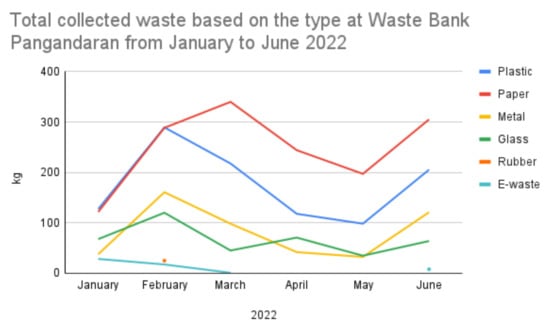
Figure 4.
Fluctuation of total waste collected (in kg) from 6 waste banks in Pangandaran from January to June 2022.
3.3. Raising Awareness on Saving the Environment through Waste Banks
The establishment of waste banks in Pangandaran is part of our method to raise awareness about waste management and preserve the environment. One of our main goals is to help people understand good waste management through waste banks. However, at this moment, waste bank customers are mainly women.
According to the waste bank customers’ behavior, it is suggested that the presence of the waste bank gradually changed the behavior of customers during the approximately one to two years after the waste bank was established. Waste sorting activities at waste banks provide a new habit for customers that indirectly encourages them to continue their activities at home (Figure 5). Customers have realized that sorting waste is an important activity for separating organic and inorganic waste and keeping the environment clean. Infrastructure changes have long-term implications on recycling behavior, according to Porter et al., (1995) and Refsgaard (2009) [21,22], who claim that they affect the attitudes and behavior of users.
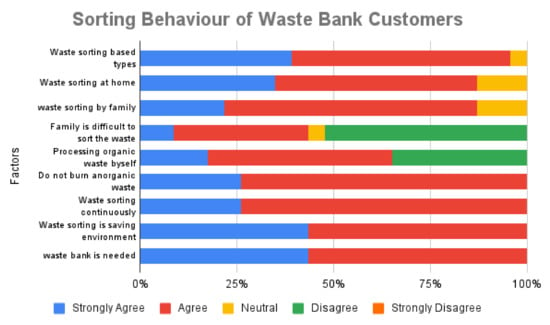
Figure 5.
Survey result on waste sorting behavior of waste bank customers.
Interestingly, customers fully agreed that the presence of a waste bank is important. They even started inviting their entire family to help sort waste at home (Figure 5). However, this procedure is complex. Introducing and implementing this new habit at home requires more time. It was revealed that approximately 40% of customers admitted that they find it difficult to enlist the help of family members in waste sorting (Figure 5). At this point, we suggest that the establishment of a waste bank is useful for raising customers’ knowledge of the need to sort and recycle both organic and inorganic waste (Figure 5). However, we found that 35% of customers opposed recycling organic waste at home.
According to the literature, there are several factors that have been identified as having an influence on waste sorting behavior in waste banks. A previous study mentioned that infrastructure (distance from the customer’s home), knowledge of waste management, experience, behavior and habits, economic level, and socio-demographic issues could influence recycling behavior [23], while another study suggested that concerns about the environment, waste management counseling, house ownership, income, building style, and level of education were listed as factors in recycling behavior [9]. Those mentioned factors were also experienced by the committee of the waste banks towards their customers in this study.
A previous study explained that socio-demographic factors, such as income, education, and occupation of family members were used to create an indicator of social class, which led them to the conclusion that people from lower social classes recycle more [23]. In line with the argument of Zakianis et al. (2017) [9], those with low incomes and education levels were more likely to sort their waste than people with high incomes and education levels. Due to the financial incentives provided for waste sorting activity, households with lower income levels demonstrated a higher propensity to recycle their waste compared to their higher-income counterparts. Gender was also found to influence recycling behavior [24], and Meneses et al. (2005) [25] concluded that women recycle more than men. According to these studies, we also found such factors as obstacles for the customers and the committees of the waste banks in this study.
Our study established the obstacles faced by customers and committees in waste banks (Figure 6 and Figure 7). Half of our waste bank customers did not have any obstacles regarding location, waste collection, waste price, and routine activity at the waste bank (Figure 6). Furthermore, some customers indicated that the waste bank location was convenient, and that they were pleased with the sorting activity at the waste bank. However, our research also shows that some customers found these points to be issues when they visited the waste bank. A previous study suggested that the difficulties in sorting and collecting waste, the low price of waste, and the location of the waste bank are some of the reasons why people do not register as customers [26]. Furthermore, another influencing factor was the uneven distribution of knowledge about waste banks. Another study indicated that the quantity of materials necessitating sorting could impede the viability of a waste bank [27]. Consequently, it is imperative for the committee to incentivize customers to self-sort and contribute their recyclable waste on a regular basis.
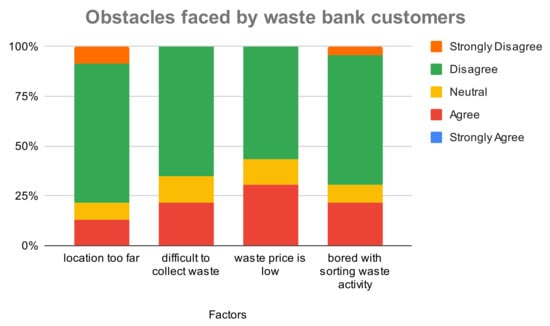
Figure 6.
Obstacles faced by waste bank customers since they registered as a part of waste bank.

Figure 7.
Obstacles faced by waste bank committees about the waste bank operation and customers’ behavior.
As shown in Figure 7, the waste bank committee agreed that consumers did not fully participate in waste sorting and were difficult to assemble at a given time. According to the committee’s survey, neither the price of waste nor the lack of additional activities at the waste bank upset customers. Additionally, they concurred that most customers were enthusiastic about the waste bank activities. The overall number of waste bank customers has increased by a factor of three since the establishment of the waste bank (Table 1). Our investigation revealed one waste bank that had not attracted any additional customers. We postulated that this may be due to a lack of belief among the residents of such villages in the potential benefits of establishing a waste bank. Moreover, a previous study reported that another significant challenge faced by waste banks is the issue of unproductive communication among actors [5], a problem that was also slightly prevalent in this study.
In our study, most waste bank customers gained many benefits from joining the waste bank (Figure 8). After gaining a deeper understanding of waste management, they became more conscious of environmental issues. Moreover, they obtain a new space to entertain themselves by meeting each other and earn extra income. A previous study suggested that waste banks benefit society by not only helping to improve the environment but also by providing extra income [28]. Waste banks educate people about waste sorting and sustainable waste processing to reduce landfill waste [29]. Moreover, some additional activities during waste bank meeting and sorting were educational for the children, which is also become an intangible benefit when a customer joins a waste bank [30,31].
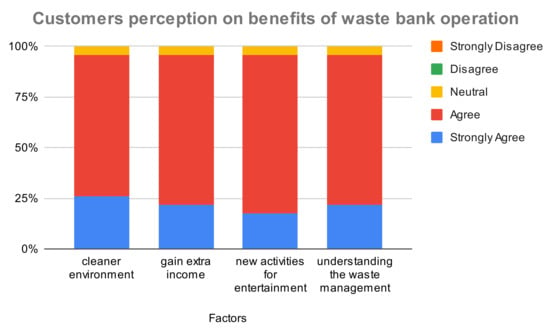
Figure 8.
Customers perception of waste bank operations.
Our study also analyzed the management operation of the waste bank from the committees’ point of view. The results showed that the committees enjoyed organizing a waste bank and had a good administration system. Both the waste bank and trader/recycler have an excellent relationship in terms of trading activity (Figure 8). We also learned that both customers and committees appreciated regular activity at the waste bank (Figure 6 and Figure 9), reflected by high number individuals who chose “disagree” in respect to “bored by sorting activity” in Figure 6, and high number who chose of “strongly agree” or “agree” in respect to “have routine activities” in Figure 9. These results indicate that the presence of a waste bank is beneficial to customers and effective in addressing environmental problems, even at the village level.
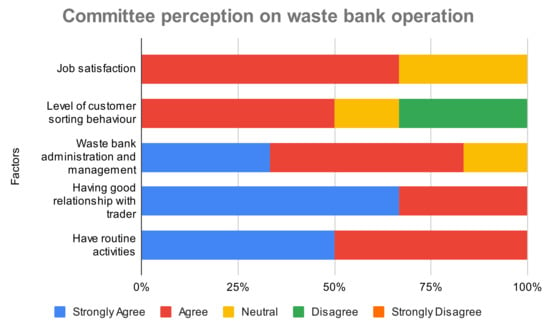
Figure 9.
Committee perception on waste bank operations.
Regarding the benefits from the customer’s point of view, some waste banks tend to self-operate and perform the waste bank activity without any assistance. Two waste banks, Lebah and Hikmah, took the initiative to hold other activities in their waste banks. Those in the Lebah waste bank perform cleaning activities in the alley and street of their living area every Friday morning, and once a month, they visit the Batu Karas beach for coastal cleanup. The Hikmah waste bank also performs additional activities like the Lebah waste bank. Moreover, the Hikmah and Lebah waste bank run a refill station business for household products, resulting in success in reducing plastic sachet waste. Additionally, in front of the RT office, they have also planted many types of crops, such as chilies, spring onions, and mint, using upcycled plastic waste as a pot.
Our team recently evaluated a new village for a waste bank, but convincing locals of its benefits proved challenging. Despite this, our existing waste bank’s strategic position demonstrates the potential for success in the right location. Factors such as the proximity of the waste bank committee members’ residences to those of the customers, as well as the distance between customer residences and the main road, influenced the type of waste generated. The ease of access to products with plastic packaging, for example, can result in a higher generation of inorganic waste in residential areas located closer to main roads. Therefore, because of the minimal amount of inorganic waste generated, they are not motivated to establish a waste bank.
The waste management industry in Indonesia is competitive, with waste banks vying for business against individual recyclers and scavengers. Without understanding the importance of waste sorting, individuals may choose to provide their waste to individual recyclers. This competition makes it more challenging to convince people to establish a waste bank.
4. Conclusions
The present study endeavored to assess the implementation of waste management systems, with a particular focus on waste banks, in Pangandaran sub-villages. This was achieved by examining the perceptions of both the committees and customers on its operationalization. Waste banks were found to be an effective and sustainable waste management system in Pangandaran sub-villages, as evidenced by the positive perceptions of both the committees (operators) and customers. Customers expressed satisfaction with the waste banks, citing their convenience and the positive impact they had on the environment. Furthermore, the presence of a waste bank creates new space for both committees and customers. Although the waste bank is affected by many factors, it is still beneficial to the environment and society. Further research could explore the potential for scaling up the waste bank model to larger communities or regions. Endorsement from municipal authorities, nonprofit entities, corporations, and additional interested parties for a cooperative methodology can augment society engagement, yield economic benefits for the populace, and enhance ecological preservation.
Author Contributions
Conceptualization, M.R.I., A.W. and N.M.; methodology, A.W., Y.S. and A.P.; investigation, M.R.I., A.W. and Y.S.; resources, Y.S., A.W. and A.P.; data curation, M.R.I. and A.W.; writing—original draft preparation, M.R.I. and A.W.; writing—review and editing, M.R.I. and A.W.; visualization, A.W. and Y.S.; supervision, Y.S. and N.M.; project administration, Y.S.; funding acquisition, M.R.I. and Y.S. All authors have read and agreed to the published version of the manuscript.
Funding
This research is jointly funded by Universitas Padjadjaran PSDKU Pangandaran Grant Number 3421/UN6.3.1/PM.00/2022.
Institutional Review Board Statement
Not applicable.
Informed Consent Statement
Informed consent was obtained from all subjects involved in the study.
Data Availability Statement
Data are unavailable due to privacy or ethical restrictions.
Acknowledgments
The authors thank to CLEAR Community for the support in conducting this study. Acknowledgement is also given to all customers of the waste banks in Pangandaran for their willingness to support this study.
Conflicts of Interest
The authors declare no conflict of interest.
References
- Ogwueleka, T. Municipal Solid Waste Characteristics and Management in Nigeria. J. Environ. Health Sci. Eng. 2009, 6, 173–180. [Google Scholar]
- Ayilara, M.S.; Olanrewaju, O.S.; Babalola, O.O.; Odeyemi, O. Waste Management through Composting: Challenges and Potentials. Sustainability 2020, 12, 4456. [Google Scholar] [CrossRef]
- Kubota, R.; Horita, M.; Tasaki, T. Integration of Community-Based Waste Bank Programs with the Municipal Solid-Waste-Management Policy in Makassar, Indonesia. J. Mater. Cycles Waste Manag. 2020, 22, 928–937. [Google Scholar] [CrossRef]
- Wijayanti, D.R.; Suryani, S. Waste Bank as Community-Based Environmental Governance: A Lesson Learned from Surabaya. Procedia-Soc. Behav. Sci. 2015, 184, 171–179. [Google Scholar] [CrossRef]
- Fatmawati, F.; Mustari, N.; Haerana, H.; Niswaty, R.; Abdillah, A. Waste Bank Policy Implementation through Collaborative Approach: Comparative Study—Makassar and Bantaeng, Indonesia. Sustainability 2022, 14, 7974. [Google Scholar] [CrossRef]
- Dhokhikah, Y.; Trihadiningrum, Y.; Sunaryo, S. Community Participation in Household Solid Waste Reduction in Surabaya, Indonesia. Resour. Conserv. Recycl. 2015, 102, 153–162. [Google Scholar] [CrossRef]
- Ismail, M.R.; Lewaru, M.W.; Prihadi, D.J. Microplastics Ingestion by Fish in the Pangandaran Bay, Indonesia. World News Nat. Sci. 2019, 23, 173–181. [Google Scholar]
- Wulandari, D.; Utomo, S.H.; Narmaditya, B.S. Waste Bank: Waste Management Model in Improving Local Economy. Int. J. Energy Econ. Policy 2017, 7, 36–41. [Google Scholar]
- Zakianis, S.; Djaja, I.M. The Importance of Waste Management Knowledge to Encourage Household Waste-Sorting Behaviour in Indonesia. Int. J. Waste Resour. 2017, 7, 1–4. [Google Scholar] [CrossRef]
- Sekito, T.; Prayogo, T.B.; Meidiana, C.; Shimamoto, H.; Dote, Y. Estimating the Flow of Recyclable Items and Potential Revenue at a Waste Bank: The Case in Malang City, Indonesia. Environ. Dev. Sustain. 2019, 21, 2979–2995. [Google Scholar] [CrossRef]
- Warmadewanthi, I.; Wulandari, D.; Cahyadi, M.N.; Pandebesie, E.S.; Anityasari, M.; Dwipayanti, N.M.U.; Purnama, I.G.H.; Nisaa, A.F. Socio-Economic Impacts of the COVID-19 Pandemic on Waste Bank Closed-Loop System in Surabaya, Indonesia. Waste Manag. Res. 2021, 39, 1039–1047. [Google Scholar] [CrossRef] [PubMed]
- Singhirunnusorn, W.; Donlakorn, K.; Kaewhanin, W. Contextual Factors Influencing Household Recycling Behaviours: A Case of Waste Bank Project in Mahasarakham Municipality. Procedia-Soc. Behav. Sci. 2012, 36, 688–697. [Google Scholar] [CrossRef]
- Miftahorrozi, M.; Khan, S.; Bhatti, M.I. Waste Bank-Socio-Economic Empowerment Nexus in Indonesia: The Stance of Maqasid Al-Shari’ah. J. Risk Financ. Manag. 2022, 15, 294. [Google Scholar] [CrossRef]
- Larasati Haryo, A.W. Dari Sampah Menjadi Upah: Inovasi Pengolahan Sampah Di Tingkat Akar Rumput Kasus Progam Bank Sampah Sendu Di Kelurahan Pasar Minggu Jakarta Selatan. J. Mns. Lingkung. (J. People Environ.) 2011, 18, 43–59. [Google Scholar]
- Supriansyah, M.; Syafari, M.R.; Nur, M.A. Community Empowerment through Waste Bank Program in Mandar Sari Kelurahan Banjar Regency. Int. J. Polit. Law Soc. Sci. 2022, 1, 49–62. Available online: https://jurnalfocus.ulm.ac.id/index.php/ds/article/view/6 (accessed on 4 May 2023).
- Visvanathan, C.; Glawe, U. Domestic Solid Waste Management in South Asian Countries—A Comparative Analysis. In Promoting Reduce, Reuse, and Recycle in South Asia; Asian Development Bank: Mandaluyong, Philippines, 2006; p. 27. Available online: https://www.iges.or.jp/en/publication_documents/pub/policyreport/en/454/00_fulltext.pdf (accessed on 4 May 2023).
- Setiyaningrum, I.F.; Wati, A.; Suryati, S. The Existence of Waste Bank Management and the Impact on the Environment and Trends of Community Consumption (Case Study of the Ngudi Resik Waste Bank, Krecekan, Wironanggan, Sukoharjo). J. Biol. Instr. 2022, 2, 9–19. [Google Scholar] [CrossRef]
- Raharjo, S.; Matsumoto, T.; Ihsan, T.; Rachman, I.; Gustin, L. Community-Based Solid Waste Bank Program for Municipal Solid Waste Management Improvement in Indonesia: A Case Study of Padang City. J. Mater. Cycles Waste Manag. 2017, 19, 201–212. [Google Scholar] [CrossRef]
- Sriyanto, D.; Intan, T.K. Household Waste Management to Improve the Community Economy via Waste Bank in Medan City. IOP Conf. Ser. Earth Environ. Sci. 2019, 245, 12038. [Google Scholar] [CrossRef]
- González-Torre, P.L.; Adenso-Díaz, B. Influence of Distance on the Motivation and Frequency of Household Recycling. Waste Manag. 2005, 25, 15–23. [Google Scholar] [CrossRef]
- Porter, M.E.; van der Linde, C. Toward a New Conception of the Environment-Competitiveness Relationship. J. Econ. Perspect. 1995, 9, 97–118. [Google Scholar] [CrossRef]
- Refsgaard, K.; Magnussen, K. Household Behaviour and Attitudes with Respect to Recycling Food Waste—Experiences from Focus Groups. J. Environ. Manag. 2009, 90, 760–771. [Google Scholar] [CrossRef] [PubMed]
- Rousta, K.; Bolton, K.; Lundin, M.; Dahlén, L. Quantitative Assessment of Distance to Collection Point and Improved Sorting Information on Source Separation of Household Waste. Waste Manag. 2015, 40, 22–30. [Google Scholar] [CrossRef]
- Iyer, E.S.; Kashyap, R.K. Consumer Recycling: Role of Incentives, Information, and Social Class. J. Consum. Behav. 2007, 6, 32–47. [Google Scholar] [CrossRef]
- Meneses, G.D.; Palacio, A.B. Recycling Behavior: A Multidimensional Approach. Environ. Behav. 2005, 37, 837–860. [Google Scholar] [CrossRef]
- Meidiana, C.; Yakin, H.A.; Wijayanti, W.P. Household’s Willingness to Accept Waste Separation for Improvement of Rural Waste Bank’s Effectivity. In Solid Waste Management in Rural Areas; Mihai, F.-C., Ed.; IntechOpen: Rijeka, Croatia, 2017; Chapter 2; ISBN 978-953-51-3486-2. Available online: https://www.intechopen.com/chapters/55775 (accessed on 4 May 2023).
- Sekito, T.; Matsuyama, A.; Prayogo, T.B.; Dote, Y. Factors Influencing the Period of Participation in a Waste Bank System in Malang City, Indonesia. J. Mater. Cycles Waste Manag. 2020, 22, 1614–1619. [Google Scholar] [CrossRef]
- Tanaka, M. Sustainable Society and Municipal Solid Waste Management. In Municipal Solid Waste Management in Asia and the Pacific Islands: Challenges and Strategic Solutions; Pariatamby, A., Tanaka, M., Eds.; Springer: Singapore, 2014; pp. 1–14. ISBN 978-981-4451-73-4. [Google Scholar]
- Asteria, D.; Heruman, H. Bank Sampah Sebagai Alternatif Strategi Pengelolaan Sampah Berbasis Masyarakat Di Tasikmalaya (Bank Sampah (Waste Banks) as an Alternative of Community-Based Waste Management Strategy in Tasikmalaya). J. People Environ. 2016, 23, 136–141. [Google Scholar] [CrossRef]
- Indrianti, N. Community-Based Solid Waste Bank Model for Sustainable Education. Procedia-Soc. Behav. Sci. 2016, 224, 158–166. [Google Scholar] [CrossRef]
- Maryati, S.; Arifiani, N.F.; Humaira, A.N.S.; Putri, H.T. Factors Influencing Household Participation in Solid Waste Management (Case Study: Waste Bank Malang). IOP Conf. Ser. Earth Environ. Sci. 2018, 124, 12015. [Google Scholar] [CrossRef]
Disclaimer/Publisher’s Note: The statements, opinions and data contained in all publications are solely those of the individual author(s) and contributor(s) and not of MDPI and/or the editor(s). MDPI and/or the editor(s) disclaim responsibility for any injury to people or property resulting from any ideas, methods, instructions or products referred to in the content. |
© 2023 by the authors. Licensee MDPI, Basel, Switzerland. This article is an open access article distributed under the terms and conditions of the Creative Commons Attribution (CC BY) license (https://creativecommons.org/licenses/by/4.0/).